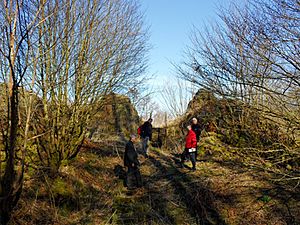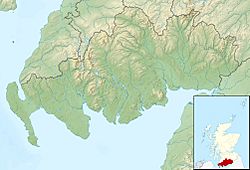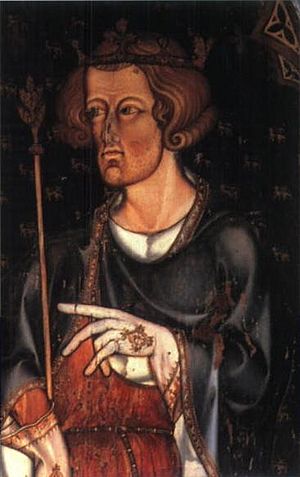Tibbers Castle facts for kids
Quick facts for kids Tibbers Castle |
|
|---|---|
| Dumfries and Galloway, Scotland UK |
|

The motte at Tibbers Castle
|
|
| Coordinates | 55°15′51″N 3°47′32″W / 55.264167°N 3.792222°W |
| Type | Castle |
| Site information | |
| Open to the public |
No |
| Condition | Ruined |
| Site history | |
| Built | 12th /13th century; rebuilt early 14th century |
| Materials | Stone |
Tibbers Castle is an old castle in Scotland, located in Dumfries and Galloway. It sits high up, looking over a shallow crossing point (called a ford) on the River Nith. To the east, you'll find the village of Carronbridge. To the north-west is Drumlanrig Castle, a large country house built in the 1500s.
Tibbers Castle started as a "motte-and-bailey" castle. This means it had a large earth mound (the motte) with a wooden tower on top, and a walled area (the bailey) below. It was likely built in the 1100s or 1200s. We first hear about it in records from 1298. Around this time, the wooden castle was rebuilt with strong stone walls.
For a while, Tibbers Castle was an important local center. It was like the main office for the area called the barony of Tibbers. But in the mid-1300s, this important role moved to a nearby place called Morton. During the wars between Scotland and England in the early 1300s, the castle was captured many times. First, Robert the Bruce and his Scottish forces took it. Then, the English captured it. Finally, the Scots got it back in 1313.
Over the years, different powerful families owned the castle, including the Earls of Moray and the Earls of March. Eventually, it came under the control of the Scottish King. A small town grew up near the castle. We don't know exactly when Tibbers Castle stopped being used. By the 1700s, the land where it stood was being used for farming. People even took stones from the castle to use for other buildings. Experts have studied the castle site several times, in 1864, 1912, and more recently in 2013–2014.
Castle History: Battles and Owners
We don't have exact records of when Tibbers Castle was first built. It might have been a wooden castle from the 1100s or 1200s. The first time it appears in written history is in 1298. This is when Sir Richard Siward either built a new stone castle or made a wooden one much stronger with stone.
King Edward I of England visited the castle in that same year, 1298. Sir Richard Siward was the Sheriff of Dumfries when the English controlled the area. Records from this time show that the castle was active. For example, in 1302, a lot of money (about £100) was spent on the castle. It also had a group of 23 soldiers guarding it.
In 1286, the Scottish King Alexander III of Scotland died without an heir. This led to a big problem over who should be the next king. Eventually, Edward I took control of Scotland. Robert the Bruce's family was one of the groups who thought they should rule Scotland. In 1306, Robert the Bruce was crowned King of Scots. This started a war with England.
One of Robert the Bruce's first goals in 1306 was to capture castles held by the English. These included castles like Ayr, Dalswinton, and Tibbers. After the Scots took Tibbers, they gave control to a man named John de Seton. However, the English soon recaptured the castle. They even hanged the Scottish defenders. Then, they put a much larger group of 54 soldiers in charge of the castle.
But in 1313, the Scots took back control of the region. From then on, Tibbers Castle stayed in Scottish hands. It was owned by Thomas Randolph, 1st Earl of Moray. After him, his son and then his grandson, John Randolph, 3rd Earl of Moray, owned it. John died in a battle in 1346. The castle then went to Patrick, Earl of March.
Patrick's son took over in 1369. He also gained control of another area called the barony of Morton. Morton likely became the new main center for the Tibbers area. The castle stayed with the Dunbar family until 1435. At that time, their lands were taken by the Scottish King. In 1450 or 1451, King James II of Scotland gave Tibbers to George Crichton, who was a very important naval officer. When George died in 1454, the castle once again became the King's property.
A small town near Tibbers Castle was mentioned in records from 1451. Even with the castle nearby, the town was attacked in 1547 by Sir Alexander Stewart. We don't know exactly when Tibbers Castle stopped being used. But by the 1700s, the land where the castle stood was used for growing crops. Some parts of the castle were even taken apart so people could reuse the stones.
For a long time, people thought Tibbers was a Roman fort. But later, they realized it was a medieval castle. The name 'Tibbers' was once thought to come from the Roman emperor Tiberius. However, it actually comes from a Gaelic word, 'Toibar', which means 'a well'.
The first known archaeological dig at Tibbers Castle happened in 1864. During this dig, they found two coins from the time of Edward II of England (1307–1327). They also found a dagger from the early 1400s. The site was mapped in 1912. No more archaeological work happened until the 2000s. In 1937, it was officially protected as a "scheduled ancient monument." In 2013 and 2014, experts used special equipment to survey the site. They used tools that could "see" things underground without digging.
Castle Design: What Tibbers Looked Like
Tibbers Castle sits on a ridge, which is like a long, narrow hill, on the west side of the River Nith. The very first castle here was a small walled area, or "bailey." This small bailey was found during the surveys in 2014. These surveys also showed that there were wooden buildings inside this early bailey.
When Richard Siward rebuilt the castle around 1298, he likely added the large earth mound (the motte). On top of this motte, he built a stone castle with walls. He also probably replaced the single small bailey with two much larger walled areas south of the motte. These larger areas might have been used for a market, similar to how Lochmaben Castle was set up. It's quite rare in Scotland to see wooden earthwork castles rebuilt with stone.
The motte, or mound, is shaped like a square with rounded corners. It measures about 44 meters by 27 meters at the top. The stone castle built on top of the motte is roughly rectangular. It measures about 26.8 meters by 11.6 meters. It had a round tower at each of its four corners. Not much of this stone castle survives above the ground today. However, the tower on the south-south-east corner is the best preserved.
The south side of the stone castle had an extra tower. This tower, along with the south-south-east corner tower, guarded the main entrance. Inside the castle, there was a well on the east side. There was also a line of buildings along the west and north sides. These buildings likely included a large hall, kitchens, and a private room (a chamber). There was also a small, secret back gate (a postern gate) just south of the north-east tower. This stone phase of Tibbers Castle is special. It's one of the few real examples of English castle building left in Scotland from when the Plantagenet kings of England controlled parts of Scotland.
At its biggest, Tibbers Castle was very large. It measured about 330 meters long and 85 meters wide. The courtyard inside the stone castle on the motte is called the inner bailey. The two larger walled areas outside it are called the outer and outermost baileys. Each of these covers an area of about 0.4 hectares (which is about one acre). The earth walls (ramparts) that surround the site are still about 0.5 meters high. They are between 3.4 and 5.5 meters wide. Having two outer baileys like this is unusual. Other castles with this feature include Windsor Castle in England and Llandinam Castle in Wales.



